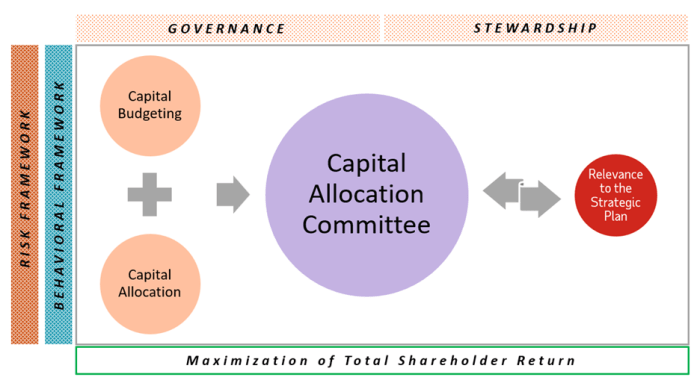
Embark on a journey into the world of capital allocation in companies, where strategic decisions shape the path to growth and success. Explore the intricate balance between risk and return, innovation and stability, in this dynamic process.
Overview of Capital Allocation Process in Companies

Capital allocation process in companies refers to the strategic decision-making process of allocating financial resources to different projects, investments, or divisions within the organization. It involves determining how to best utilize the available capital to maximize returns and drive growth.
Methods of Capital Allocation
- Internal Rate of Return (IRR): Companies use IRR to evaluate the potential return of an investment based on the time value of money. Projects with higher IRR are typically preferred as they offer higher returns.
- Net Present Value (NPV): NPV helps companies assess the profitability of an investment by discounting the future cash flows to their present value. Projects with positive NPV are considered financially viable.
- Capital Budgeting: Companies use capital budgeting techniques such as payback period, profitability index, and discounted payback period to evaluate investment opportunities and allocate capital accordingly.
Importance of a Well-Defined Capital Allocation Process
A well-defined capital allocation process is crucial for company growth and sustainability. It ensures that resources are allocated efficiently to projects that align with the company’s strategic objectives and have the potential to generate long-term value. By prioritizing investments based on rigorous financial analysis, companies can optimize their capital allocation decisions and drive profitability.
Factors Influencing Capital Allocation Decisions
When making capital allocation decisions, companies take into account various factors that can influence their choices. These factors can be categorized as internal or external, each playing a crucial role in the decision-making process. Additionally, market conditions also have a significant impact on how businesses strategize their capital allocation efforts.
Internal Factors
Internal factors refer to aspects within the company that directly influence capital allocation decisions. These factors may include the company’s financial goals, available resources, risk tolerance, and overall corporate strategy. By evaluating these internal factors, companies can determine the best way to allocate their capital to achieve their desired outcomes.
External Factors
On the other hand, external factors are elements outside the company that can impact capital allocation choices. These factors may consist of economic conditions, industry trends, regulatory environment, and competitive landscape. Companies need to consider these external influences to adapt their capital allocation strategies accordingly and remain competitive in the market.
Market Conditions
Market conditions play a crucial role in shaping capital allocation strategies in businesses. For instance, during periods of economic uncertainty or market volatility, companies may prioritize preserving cash and reducing risk exposure. On the contrary, in times of economic growth and stability, businesses may focus on expansion and investment opportunities to capitalize on favorable market conditions.
Role of Leadership in Capital Allocation
Leadership plays a crucial role in overseeing and guiding the capital allocation process within companies. Effective leaders are responsible for making strategic decisions that align with the organization’s goals and objectives while maximizing shareholder value.
Examples of Successful Leadership Strategies in Capital Allocation
- Setting clear financial goals and priorities to ensure resources are allocated efficiently.
- Establishing a robust evaluation framework to assess and prioritize investment opportunities.
- Encouraging a culture of accountability and transparency to ensure the capital allocation process is fair and objective.
- Regularly reviewing and adjusting capital allocation strategies based on performance and market conditions.
Impact of Leadership Styles on Capital Allocation Decisions
Leadership styles can have a significant impact on the effectiveness of capital allocation decisions. For example, autocratic leaders may make unilateral decisions without considering input from others, which can lead to suboptimal outcomes. In contrast, participative leaders who involve key stakeholders in the decision-making process are more likely to make informed and strategic capital allocation decisions that benefit the company in the long run.
Capital Allocation Strategies for Growth

Companies prioritize capital allocation for growth opportunities by carefully evaluating various factors such as market trends, competitive landscape, internal capabilities, and strategic goals. They aim to maximize returns on investment while minimizing risks.
Balancing Existing Operations and New Ventures
Companies often face the challenge of deciding between investing in existing operations to enhance efficiency and profitability or pursuing new ventures for potential growth opportunities. The key lies in striking the right balance to ensure sustainable growth in the long run.
Evaluation of Risks and Returns
When allocating capital for growth, companies conduct thorough risk assessments to understand the potential downside of each investment. They also analyze expected returns to determine the feasibility and profitability of the growth opportunity. By weighing these factors carefully, companies can make informed decisions to maximize the value of their investments.
As we conclude our exploration of capital allocation in companies, remember that effective strategies can pave the way for sustainable growth and profitability. By understanding the key factors and leadership roles involved, businesses can navigate the complexities of allocating capital with confidence and foresight.
FAQ Overview
How do companies prioritize their capital allocation decisions?
Companies prioritize their capital allocation decisions by assessing various factors such as growth opportunities, risks, and potential returns.
What role does leadership play in the capital allocation process?
Leadership oversees and guides the capital allocation process, ensuring strategic decisions align with the company’s goals and vision.
Why is a well-defined capital allocation process important for company growth?
A well-defined capital allocation process is crucial for company growth as it helps in maximizing resources, identifying growth opportunities, and managing risks effectively.





